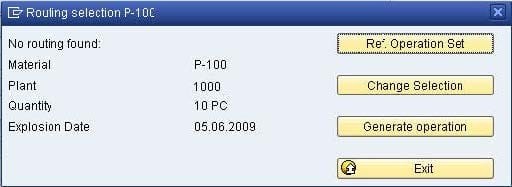Exam Details
Exam Code
:C_TSCM42_65Exam Name
:SAP Certified Application Associate - Production - Planning & Manufacturing with SAP ERP 6.0 EHP5Certification
:SAP CertificationsVendor
:SAPTotal Questions
:60 Q&AsLast Updated
:Nov 26, 2024
SAP SAP Certifications C_TSCM42_65 Questions & Answers
-
Question 21:
What functions can you use for suboperations? (Choose two)
A. Material component allocation
B. Production/Resource tools allocation
C. Capacity planning
D. Costing
-
Question 22:
In which scenario will the error message shown in the attached screenshot occur?

A. The selection method is set to "selection only by production version" in the material master.
B. The routing is not valid at the explosion date.
C. The Customizing for the order type is set to manual routing selection and a valid routing exists.
D. The material master is set to manual routing selection and a valid routing exists.
-
Question 23:
Which master data is necessary for the creation of material reservations for production orders?
A. Material master records
B. Routings
C. Production versions
D. Production/resource tools
-
Question 24:
Which of the following statements regarding lot size procedures is correct?
A. The lot size quantity can be influenced using a minimum lot size and the rounding profile.
B. If a make-to-order production strategy is used, only the lot-for-lot (exact) lot size can be applied.
C. If a long-term lot size is used, procurement is conducted with a long-term perspective.
D. The procurement quantity of a lot size procedure can be specified using a safety time period profile.
-
Question 25:
Which of the following elements can be used in a process order? (Choose three)
A. Phases
B. Process instructions
C. Relationships
D. Suboperations
E. Parallel sequences
-
Question 26:
Which of the following statements about ATP (Available To Promise) checks for material components are correct? (Choose two)
A. ATP checks are automatically performed during Material Requirements Planning (MRP) runs.
B. ATP checks are used to evaluate the free capacity on a certain work center.
C. ATP checks can be adjusted to also consider future requirements and receipts.
D. ATP checks can be carried out automatically when releasing a production order.
E. ATP checks are mandatory for lead-time scheduling.
-
Question 27:
You select the master data for production orders via production versions.
Which information is contained in a production version?
A. The control parameters for selecting routings and BOM
B. The default order type to be used
C. The routing and BOM alternatives to be used
D. The explosion dates for the routing and BOM
-
Question 28:
What is SAP Solution Manager?
A. A part of the SAP ECC System
B. A managed system in a system landscape
C. A stand-alone system that communicates with other systems in a system landscape
D. An add-on industry solution
-
Question 29:
What data can be posted directly via the Plant Data Collection (PP-PDC) interface?
A. Goods receipts
B. Goods issues
C. Maintenance notifications
D. Confirmations
-
Question 30:
During a project phase, your customer raises some questions concerning parameters of the procurement type in the material master in the SAP ECC system.
Which of the following procurement type properties are valid? (Choose two)
A. If procurement type E (in-house production) is set, external procurement may still be possible depending on the material type.
B. A material's procurement type can be freely selected between E (in-house production), F (external procurement) and X (both procurement types) independent of material type.
C. Procurement types E (in-house production) and F (external procurement) have to be further refined with special procurement types.
D. If both procurement types are allowed with entry X (both procurement types), requirements planning assumes in-house production.
Related Exams:
C_ABAPD_2309
SAP Certified Associate - Back-End Developer - ABAP CloudC_ACT_2403
SAP Certified Associate - Project Manager - SAP ActivateC_ACTIVATE05
SAP Certified Associate - SAP Activate Project ManagerC_ACTIVATE12
SAP Certified Associate - SAP Activate Project ManagerC_ACTIVATE13
SAP Certified Associate - SAP Activate Project ManagerC_ACTIVATE22
SAP Certified Associate - SAP Activate Project ManagerC_AIG_2412
SAP Certified Associate - SAP Generative AI DeveloperC_ARCIG_2404
SAP Certified Associate - Implementation Consultant - Managed Gateway for Spend Management and SAP Business NetworkC_ARCON_2404
SAP Certified Associate - Implementation Consultant - SAP Ariba ContractsC_ARP2P_2105
SAP Certified Application Associate - SAP Ariba Procurement
Tips on How to Prepare for the Exams
Nowadays, the certification exams become more and more important and required by more and more enterprises when applying for a job. But how to prepare for the exam effectively? How to prepare for the exam in a short time with less efforts? How to get a ideal result and how to find the most reliable resources? Here on Vcedump.com, you will find all the answers. Vcedump.com provide not only SAP exam questions, answers and explanations but also complete assistance on your exam preparation and certification application. If you are confused on your C_TSCM42_65 exam preparations and SAP certification application, do not hesitate to visit our Vcedump.com to find your solutions here.